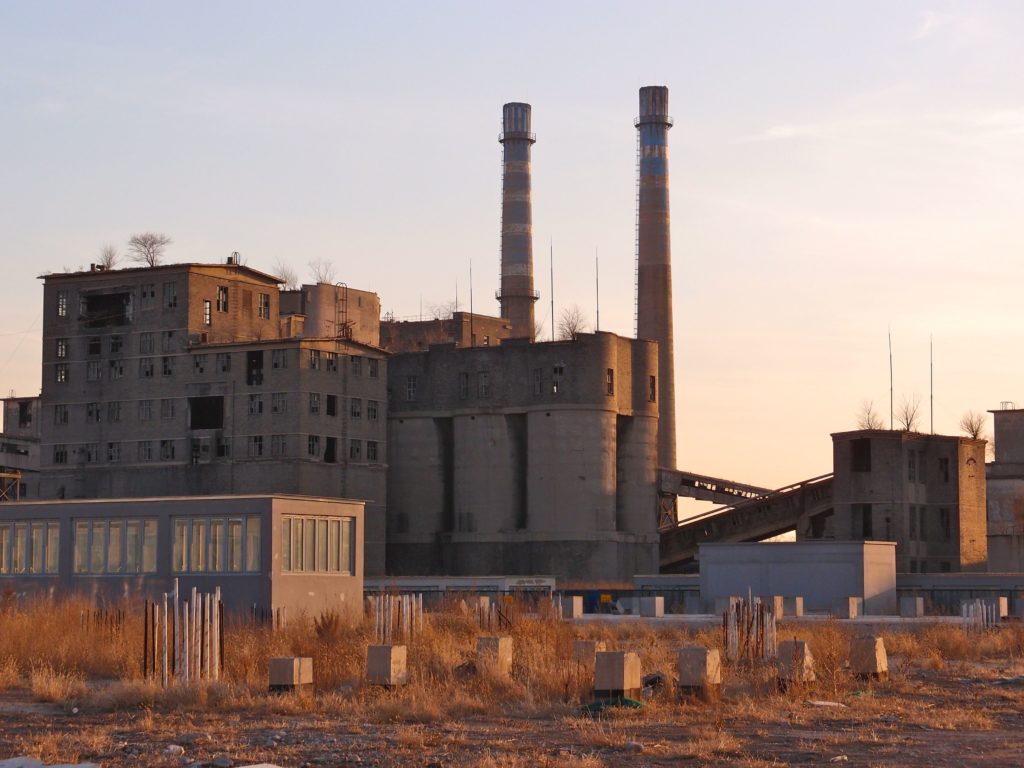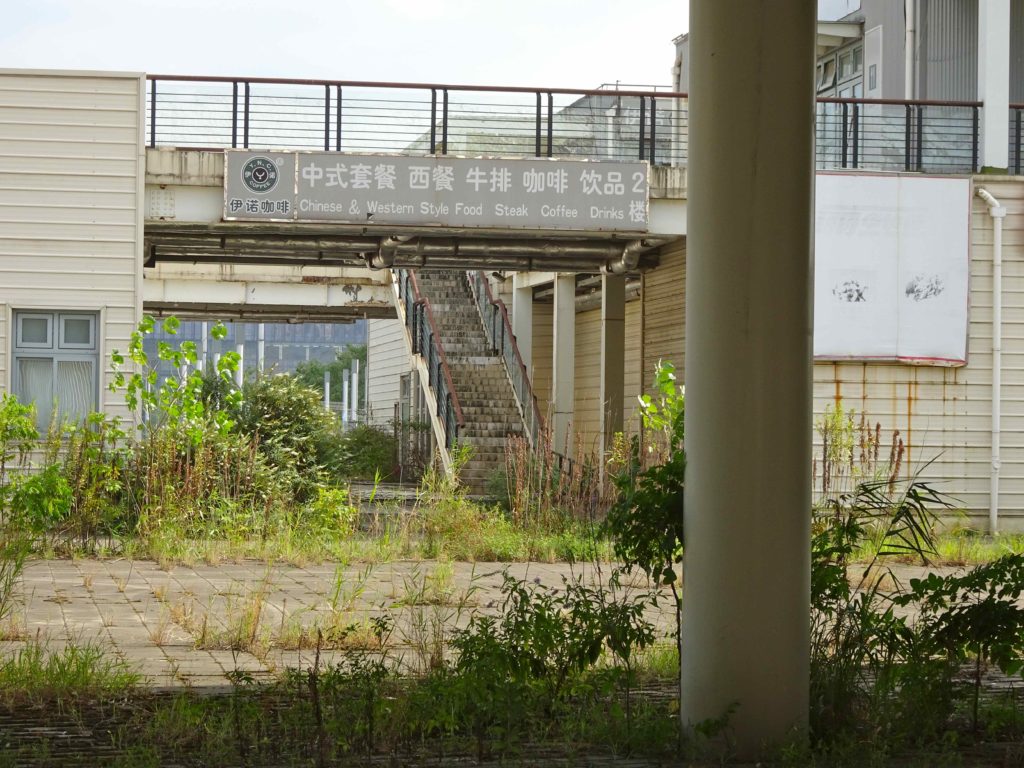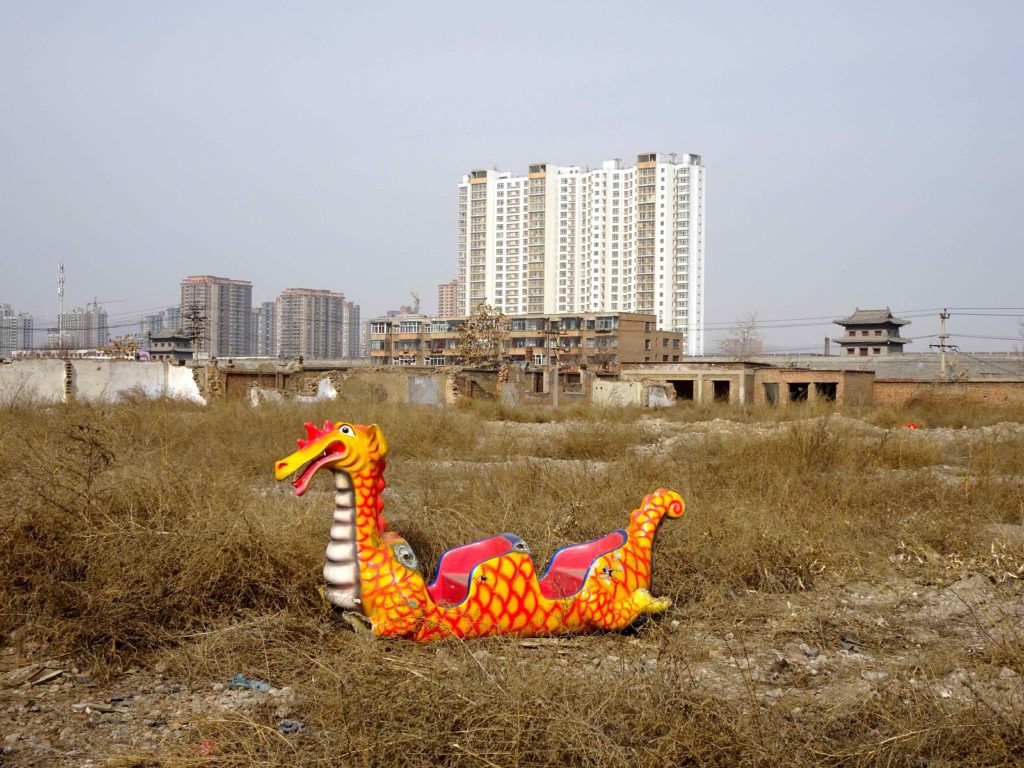Dr Judith Audin, researcher, CEFC Hong Kong, chief editor, China Perspectives
jaudin@cefc.com.hk
Open Call for Participation
邀请参与我们的网络!
Research Network on Urban Ruins in Contemporary China
当代中国城市废墟的研究网络
This concept note aims to build an international research group of scholars, artists, and urban explorers focusing on ruins and ruination processes in urban China.
Urban ruins constitute a ubiquitous architectural feature in contemporary China: from the rubble of urban demolition operations to the empty newly-built ghost towns, from industrial wastelands to forgotten historical buildings falling in disrepair, from abandoned theme parks to the slow decline of villages emptying as younger generations move to cities. The familiar strangeness of such ruined landscapes deserves a more thorough study. They operate a critical understanding of urban development by highlighting economic, ecological, and social crises.

• Theme 1: Ruination processes in contemporary China
Ruins are in close connection with time and temporality (Augé 2003; Garrett 2011). The first theme focuses on processes of ruination in China. How do ruinscapes form and evolve in Chinese cities? Some ruination processes are fast and others are much slower. This research could bring together different ruination processes in China, going from urban demolition and disappearance in the case of residential ruins (Wu, Zhang, and Webster, 2013; Qin 2013; Ho 2013; Ren 2014) to the dismantling of industrial complexes and the new cultural politics of “art clusters” in China, or to the study of newly-built “ghost cities” (Woodworth and Wallace 2017), and it could even focus on depopulating villages in rural China. Ruination is understood in a large scale, including the temporality of urban decay, the factors leading to situations of failed architecture (Ulfstjerne 2017), of abandonment, of disrepair (Chu 2014). This theme also deals with memory, exploring the temporality of forgetting, for example in the case of “extreme” urban ruins caused by natural disasters like the vestiges of the 2008 Sichuan earthquake (Xu 2018). Which factors contribute to “erasing” the existing building from the urban fabric? The politics of memory, nostalgia, and indifference are important research topics, as well as ethnographies of traces (Ginzburg 1980) in order to understand different trajectories of place un-making.
• Theme 2: The effects and affects of urban ruins in contemporary China
The second theme focuses on studying the social life (and death) of derelict buildings, but also the marking that affect such spaces, turning them into marginal or even “non-places” (Augé 1992), socially invisible places (Huang and Yi 2015). In this theme, research on urban decline (Mah 2012), resistance (Ho 2013), and resilience (Vale and Campanella 2015) in Chinese cities would shed light on the social processes around these ruined spaces. What effect do urban ruins have on the production of the urban space? How do ordinary people (re)create communities, lifestyles, and economic activities in semi-abandoned or half-demolished neighbourhoods? What kinds of subjectivities and desires (Rofel 2007) are expressed by the last occupants through the everyday appropriation of these landscapes? Ethnographic research on the social representations of ruins in China and on the social practices of ruins in Chinese cities, but also on the traumas, myths and legends (haunted places?) of such places would contribute to this theme.
• Theme 3: The texture of urban ruins in contemporary China
Researching the texture of Chinese contemporary ruins by documenting their materiality, smells, and sounds is a way to build a reflection on the sensory dimension of such spaces and to provide another understanding on Chinese urbanity, between the city and the wilderness (Jorgensen and Keenan 2012). By carrying fieldwork in such spaces, by looking more closely at derelict architecture, the research group could raise discussions on the dialectics of density, emptiness, finding ways to describe more accurately the concrete nature of “anti-spaces”, or “in-between” spaces in a city. The various forms of deterioration that can be understood through the uses of such ruinscapes and the vocabulary (in mandarin Chinese and local dialects) used by the local population to describe and qualify such spaces (ruins, abandoned buildings, wastelands, trashed places, urban farmlands, parking lots, playful places, empty and silent spaces?).
• Theme 4: Documenting urban ruins. The politics and ethics of urban exploration in China
The network will finally try to build a collective reflection on the methodology of exploring urban ruins in China, trying to build new research designs in the fields of history (Wu 2012), urban ethnography and visual methods (Ortells-Nicolau 2015). Bringing in new fieldwork practices in urban China such as urban exploration (Ninjalicious 2005; Garrett 2014a, 2014b; Davidov 2016) can be a way to infiltrate undocumented places but also to access new fields of knowledge and offer a critical understanding of the Chinese city by considering urban “anomalies” like ruins as part of the cityscape, and as aesthetic objects (Nieszczrzeweska 2015). The crisscrossing of different disciplines and methods is a way of transcending frontiers between the arts (photography, documentary films) and academic research in social sciences (Lam 2015) to elaborate alternate and critical visions of cityscape in contemporary China.

This research group welcomes scholars, urban explorers, and artists in all fields of the social sciences, to show interest and start exchanging about urban ruins, forgotten places and derelict spaces in China. Comparative approaches with Hong Kong, Taiwan, and East Asia, or even post-communist societies are also welcome.
If you are interested in joining this group and organising discussions, projects, events, and conferences together in the future, please send an email to jaudin@cefc.com.hk with a quick bio and a description of your current research/artwork.
Download PDF file here: Call for Participation Network on Ruins in China
References
AUGÉ, Marc. 2003. Le temps en ruines. Paris: Galilée.
AUGÉ, Marc. 1992. Non-lieux: introduction à une anthropologie de la surmodernité. Paris: Seuil.
ULFSTJERNE, Michael A. 2017. “The Tower and the Tower: Excess and Vacancy in China’s Ghost Cities” In Susanne Bregnbæk, Mikkel Bunkenborg (eds.). Emptiness and Fullness: Ethnographies of Lack and Desire in Contemporary China. New York: Berghahn.
CHU, Julie Y. 2014 “When infrastructures attack: The workings of disrepair in China”, American Ethnologist 41(2): 351-67.
DAVIDOV, Veronica. 2016. “Abandoned Environments: Producing New Systems of Value Through Urban Exploration.” In Ismael Vaccaro, Krista Harper, and Seth Murray (eds.), The Anthropology of Postindustrialism: Ethnographies of Disconnection, New York: Routledge. 147-65.
GARRETT, Bradley L. 2011. “Assaying History: Creating Temporal Junctions Through Urban Exploration,” Environment and Planning D 29: 1048‑1067.
GARRETT, Bradley L. 2014a. Explore Everything: Place-Hacking the City, London: Verso.
GARRETT, Bradley L. 2014b. “Undertaking Recreational Trespass: Urban Exploration and Infiltration”, Transactions of the Institute of British Geographers 39(1): 1‑13.
GINZBURG, Carlo. 1980. “Signes, traces, pistes. Racines d’un paradigme de l’indice.” Le Débat: 3‑44.
HO, Cheuk Yuet. 2013. “Exit, or Evict: Re-grounding Rights in Needs in China’s Urban Housing Demolition.” Asian Anthropology 12(2): 141-55.
HUANG, Youqin, and Chengdong YI. 2015. “Invisible migrant enclaves in Chinese cities: Underground living in Beijing, China.” Urban Studies 52 (15): 2948-73.
JORGENSEN, Anna, and Richard KEENAN (eds). 2012. Urban Wildscapes. New York: Routledge.
LAM, Tong. 2013. “Photo Essay: Unreal Estate and China’s Collective Unconscious,” Cross-Currents: East Asian History and Culture Review 10, https://cross-currents.berkeley.edu/e-journal/issue-10/unreal-estate/statement (consulté le 23 octobre 2017).
MAH, Alice. 2012. Industrial Ruination, Community and Place: Landscapes and Legacies of Urban Decline. Toronto: University of Toronto Press.
NIESZCZRZEWESKA, Małgorzata. 2015. “Derelict Architecture: Aesthetics of an Unaesthetic Space.” Argument 5: 387‑97.
NINJALICIOUS. 2005. Access All Areas: A User’s Guide to the Art of Urban Exploration. Canada: Infilpress.
ORTELLS-NICOLAU, Xavier. 2015. Urban Demolition and the Aesthetics of Recent Ruins in Experimental Photography from China, PhD Dissertation: Translation and Inter-cultural studies: Autonomous University of Barcelona.
QIN, Shao. 2013. Shanghai Gone: Domicide and Defiance in a Chinese Megacity. Lanham: Rowman & Littlefield.
REN, Xuefei. 2014. “The Political Economy of Urban Ruins: Redeveloping Shanghai.” International Journal of Urban and Regional Research 38(3): 1081-91.
ROFEL, Lisa. Desiring China: Experiments in Neoliberalism, Sexuality, and Public Culture. Durham: Duke University Press.
SHEPARD, Wade. 2015. Ghost Cities of China: The Story of Cities Without People in the World’s Most Populated Country, London: Zed Books.
SORACE, Christian, and William HURST. 2016. “China’s Phantom Urbanization and the Pathology of Ghost Cities,” Journal of Contemporary Asia 46(2): 304‑22.
VALE, L. J. and Thomas J. CAMPANELLA. 2005. The Resilient City. How Modern Cities Recover from Disaster. New York: Oxford University Press.
WOODWORTH, Max D., and Jeremy L. WALLACE, 2017. “Seeing Ghosts: Parsing China’s ‘Ghost City’ Controversy.” Urban Geography 38(8): 1270-81.
WU, Fulong, Fangzhu ZHANG, and Chris WEBSTER. 2013. “Informality and the Development and Demolition of Urban Villages in the Chinese Peri-urban Area.” Urban Studies 10(50): 1919-34.
WU, Hung. 2012. A Story of Ruins Presence and Absence in Chinese Art and Visual Culture. Princeton University Press.
XU, Bin. 2018. The Politics of Compassion: The Sichuan Earthquake and Civic Engagement in China. Stanford: Stanford University Press.
